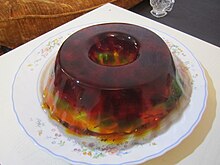jelly
Jelly (from French gelée borrowed and returning to the Latin gelare "freeze" for or "solidified bring" even jelly , Jell-O ) or Sulz called designated foods with jelly-like consistency that can be made different. Meat jelly made from meat broth ( aspic ) is used, for example, for brawns , to shine and to bind sauces , fruit jelly made from fruit juice for jams and desserts . From a chemical point of view, these substances are gels .
In terms of food law, jellies made from aqueous extracts of fruit or concentrated fruit juice are called simple jelly (fruit juice content of at least 35%) or extra jelly (fruit juice content of at least 45%).
Manufacturing
The formation or manufacture of jelly is called gelling or gelation . In chemistry, the production of gels is also called gelling .
For jellies for salty dishes, veal's feet are traditionally added to a meat broth and boiled. In fish dishes , bones in the fish stock serve the same purpose. A chicken broth cooked slowly and sufficiently concentrated will gel without any further aids. To get a clear jelly, the broth must be degreased . In these processes, the gelatin contained in the bone substance is responsible for gelling.
Sweet jellies are usually boiled with fruit juice , possibly sugar , flavor , coloring and a gelling agent and gel when they cool. They are popular as desserts (e.g. jelly ), on cakes and tarts ( icing ), or as a spread .
A gelling agent can also be added when making jam and marmalade , for example by using gelling sugar , but some fruits, for example apples , already contain sufficient amounts of natural pectins to prevent gelling when boiled with sugar and possibly acid ( lemon ) cause. The peel of citrus fruits is also a natural source of pectin.
Gelling aid
Gelling agents used in the art of cooking and the food industry are made from multiple sugars or vegetable and animal proteins .
Gelatine is produced industrially from slaughterhouse waste and offered in pure form as leaf gelatine or ground. It is tasteless and can therefore be added to salty and sweet dishes. Cake icing or gummy candies are usually based on gelatine and are therefore not vegetarian, in many cases also not kosher or halāl , as the skin and bones of pigs are used, among other things .
Preserving sugar is enriched with pectin and enables low-pectin fruits to be processed into jams and fruit jellies without any further additions. In addition, there is also pure pectin, e.g. B. in liquid form that can be added to food.
Also sugar and cornstarch (u potato starch, wheat starch, corn starch. A.) Producing a stiffening adhesive effect. In addition to sugar, commercially available jellies often contain glucose and fructose syrup as well as citric acid as a gelling aid.
The agar obtained from algae is used as a strong, tasteless gelling agent in the food industry and as a vegan (and therefore also vegetarian ) alternative to gelatine. This also applies to the carrageenan obtained from red algae .
Whipping aid
In principle, all dishes can be whipped similar to whipped cream with enough gelling agents. This is made possible by the proteins it contains . In the solidified state, i.e. when the chemical process has already been completed, this is no longer possible. Until the advent of molecular gastronomy, these possibilities were almost only known to food chemists.
Food chemistry
The special thing about jellies is their extraordinary ability to trap water in macromolecules and thus “solidify” it when the mixture of water and gelling agent cools. Several deciliters of water can be bound with a sheet of gelatine (about two grams). This process is reversible when the jelly is heated. In the case of the gel formers used in the kitchen, this temperature is around 30 ° C, so the jelly melts in the mouth and releases the flavoring substances it contains.
Gelatin , the main gelling agent in cooking, is made from the collagen in the muscle fibers and bones of animals. The collagen molecules, which form tough fibrils ( connective tissue ), are split off and loosened by boiling or the action of acids or bases. As the solution slowly cools down, the collagen molecules combine to form long, tangled chains that bind large amounts of water molecules - the jelly solidifies. Too fast cooling or movement can disrupt the process and the jelly remains more or less liquid.
Pectin is the basis for fruit jellies. It is found in many fruits, especially apples. To release it from the cell walls, fruits rich in pectin are boiled with sugar. The sugar removes water from the cells, destroying their walls and making it easier for the pectin to be released. If there is enough sugar in the solution, the released water binds to the sugar - the pectin molecules can only react with each other and no longer with the water. However, so that they combine to form a framework in which the water is “locked in” when they cool down, they must be present in sufficient concentration and the solution must be acidic, otherwise the pectin molecules will repel each other (through ionization). The ideal pH value is 3.3.
Other uses
Beyond the art of cooking, gelling agents such as gelatine and others are used because of their ability to store large amounts of water or aqueous solutions, and because of their adhesiveness in a variety of ways - from bone glue to photo emulsion to diapers . In these technical contexts one speaks of gel instead of jelly.



